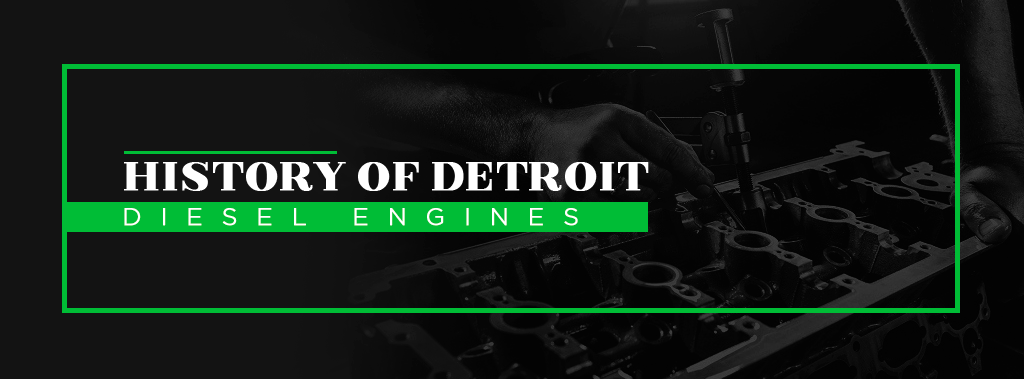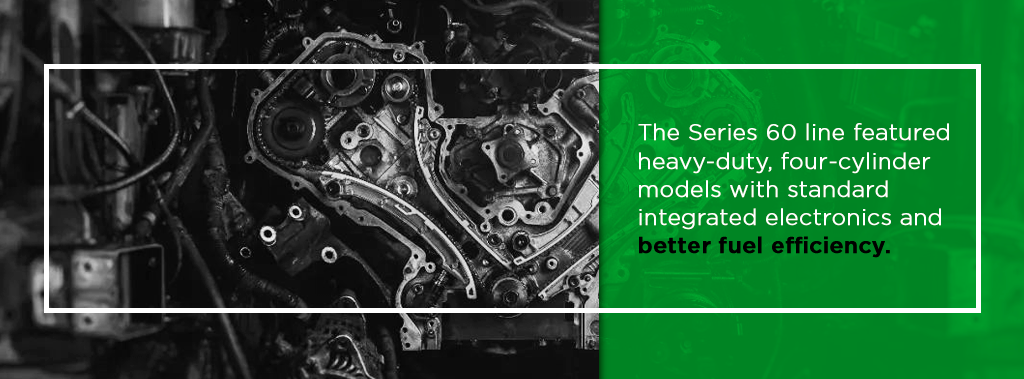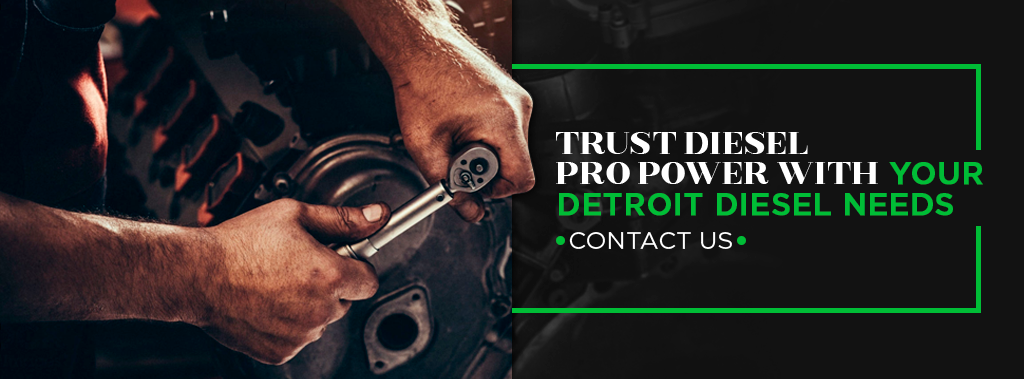
The rich history of Detroit Diesel includes over 75 years of evolution and development. They’re known today as one of the world’s leading diesel engine producers, alongside the products of top-name companies like Cummins. While the story of the diesel engine starts in the late 1800s in Europe with a man named Rudolf Diesel, the Detroit Diesel timeline begins in the U.S in the 1930s. This guide will teach you about Detroit Diesel engines, from their inception to their influence in the current day.
The Beginning Stages
At its earliest stages, Detroit Diesel began with an experiment run by the General Motors (GM) company. In 1930, GM became interested in refining Rudolf Diesel’s engine model, as there were a few issues that kept it from reaching its full potential. At the time, it was only being used in ships and stationary machines. GM began experimenting with a single-cylinder engine, aptly nicknamed “Big Bertha.” Their goal was to cut down on size and weight while increasing the cylinder count.
They field-tested their ideas as part of the Chicago’s World Fair in 1933. GM built two 8-cylinder, 600-horsepower engines to provide electric for the GM Exhibits Building. They were a quarter of the size and one-fifth of the weight of previous diesel engines with the same power. It served as a testament to the potential that diesel-powered engines had. Developers observed that they could improve efficiency, and decided to pursue the engines further.
But the direct history of Detroit Diesel begins in 1938 when GM formed its GM Diesel Division. This development occurred during the Great Depression, when families were struggling to support themselves, and war was breaking out in Europe. As WWII was escalating, manufacturers produced heavy-duty equipment, such as tanks, stand-by generators, landing boats and other crucial equipment.
However, the issue occurred that these machines were in need of an improved engine model, with a more lightweight and compact build. As a response, the GM Diesel Division released a new line of engines, the two-cycle Series 71. They sold fast and were a reliable power source for the equipment of WWII. With such a large role in the war, GM’s diesel engines began to gain real traction.
Advances in the 1950s and 1960s
After WWII came to a close, much of the military equipment lost its use. At the same time, railroads began to lose their importance. But throughout the 50s and 60s, the diesel engine continued to rise in popularity. GM continued to produce the engines and develop the design further. Their focus shifted to highway trucks, where they would be able to grow their client list and expand as a company.
GM began developing heavy-duty diesel engines to meet the needs of businesses and created a distribution network of dealers and distributors. By 1955, GM was already selling the earliest models to new and old customers. In 1957, they released the Series 53 engine, which brought their brand even more attention. The group included two-, three- and four-cylinder models and targeted the on-highway market.
The Series 53 line proved itself to be powerful and highly useful in multiple applications. They work well in ground support machines at airports, capable of hauling luggage and towing airplanes. Construction equipment adopted the 4-cylinder Series 53N model and use it in logging skidders and backhoes. The military also continued to use diesel, putting the 6V53T in armored carriers. GM kept the Series 71 engines as well, but decided to keep their parts interchangeable moving forward, so clients could add more cylinders to their existing engine.
In 1965, there was a big shift. GM’s Diesel Division became the Detroit Engine Division. From there, they consolidated with the Allison Division, which produced transmissions and gas turbines. In 1970, the merge officially became known as the Detroit Allison Divison, and it would remain as such through nearly the next 20 years.
The Evolution Through the 1970s and Into the New Millennium
Now known as Detroit Allison, the company continued to flourish and grow, keeping sales high. In the decade between 1970 and 1980, Detroit Allison grew to dominate a significant chunk of the growing diesel engine market, while competing with the leading manufacturer, Cummins. And their successes would only grow when they released their Series 60 engine in 1987.

The Series 60 line featured heavy-duty, four-cylinder models with standard integrated electronics and better fuel efficiency. It was the first of its kind, as no engine before included electronic controls as a standard addition. In a short time, it became the best selling diesel engine for Class 8 trucks in the North American market.
In 1988, shortly after the introduction of the Series 60, GM and the Penske Corporation began to collaborate. They worked together to create the Detroit Diesel Corporation. Roger Penske, owner of the Penske Corporation, held a majority ownership stake in the new organization, and under his leadership, it flourished.
Despite a depressed economy in 1990 and 1991, the Detroit Diesel Corporation came out on the other side with a $20 million net income in 1993. In the same year, the New York Stock Exchange began listing them as “DDC,” and they controlled about 33% of the on-highway market.
Their next big shift came with the turn of the millennium. In 2000, German automaker DaimlerChrysler purchased the Detroit Diesel Corporation for about $700 million, through a major stock buyout. It became a part of the Daimler Trucks of North America organization.
When 2005 rolled around, the Detroit Diesel Corporation decided to invest in their own business. They spent over $300 million refurbishing their production plant and upgrading their tools. With so much progress happening so quickly, the company decided it was time to release a new engine line. Thus, the Heavy-Duty Engine Platform and the DD engine line were born, featuring models like the DD13, DD15, DD15TC and DD16. As an additional milestone, in 2009, the Detroit Diesel Corporation sold its millionth Series 60 engine.
The Detroit Diesel Engine Today
From 2010 to the current day, the Detroit Diesel Corporation and its engines have continued to grow and develop. They’ve launched several new concepts, such as their BlueTEC® emissions technology and their Remote Diagnostics System. The company has expanded to provide many different parts and services so owners can take care of their engines for years of use. In 2011, they reflected their intent to extend their reach by simplifying the company name to Detroit.
Along with offering parts, the company still manufactures a full lineup of engines for mid to heavy-duty range applications. Their engines are all compliant with the 2017 EPA greenhouse gas regulations. Additionally, they produce transmissions, safety systems and telematics to accompany their engines. Detroit’s products are still setting industry standards to this day.
As far as applications go, Detroit engines are essential to a broad variety of industries, from pleasure crafts and boats to generators and other industrial uses. Their network reaches far and wide, with over 800 parts and distribution centers throughout North America alone. They supply companies around the world with high-quality products and ensure their engines continue running for hundreds of thousands of miles.
The history of the Detroit Diesel Corporation is storied and rich. From the 1930s to now, the company has built itself into a globally recognized brand, and one of the top engine manufacturers on the market.
Trust Diesel Pro Power With Your Detroit Diesel Needs
At Diesel Pro Power, we’re proud to offer components for the many Detroit Diesel engine models and Allison transmissions that power thousands of companies. From industrial uses to marine engines, our goal is to provide the best possible service and keep your diesel engines running for years to come. We offer parts for the 53, 71, 92, 149 and 60 engine series and make it easy to find the parts you need.
With over 15,000 satisfied customers, 24-hour shipping worldwide and a 100% quality guarantee, you can put your confidence in Diesel Pro Power. For more information about our parts and services, contact us or explore our helpful resources.



 Free US Calls: 1-888-433-4735
Free US Calls: 1-888-433-4735 International: 305-545-5588
International: 305-545-5588
